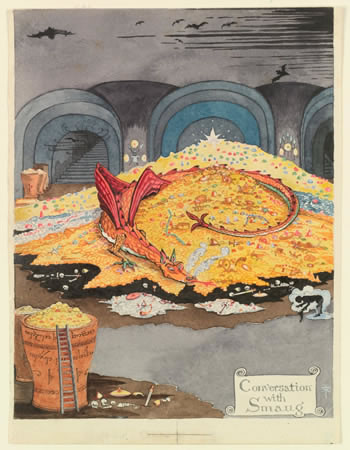Original illustration to The Hobbit, Conversation with Smaug, on display at the Bodleian Library (27.11.11 by Pieter Collier) -
Comments
The 400-year old Bodleian is globally acknowledged to be one of the greatest libraries in the world. Its collections include the papers of six British prime ministers; a Gutenberg Bible; the earliest surviving book written wholly in English; a quarter of the world's original copies of the Magna Carta; the original manuscript of Frankenstein; J.R.R. tolkien's original artwork which was used to illustrate The Hobbit, as well as a unique manuscript of Hobbit doodles and over 10,000 medieval manuscripts.
When Sir Thomas Bodley re-founded the University Library at the beginning of the 17th century, he asked that a cabinet be reserved for items that were 'most singular and rare'. One of the Bodleian's early librarians also requested that the 'strength and flower' of the collections should be kept in a separate space, where it could be shown to visitors.
What is it that makes a particular book or manuscript special from a collection of several million items at the Bodleian today? What makes it a 'treasure'? It may be its age, rarity or beauty; it may be of great scholarly importance, or have the ability to provoke strong emotions, or simply be an accidental survival, a curiosity
A first lot of 'treasures' will be on display in an exhibtion called 'Treasures of the Bodleian'. One of the high-lights will be tolkien's illustration Converstion with Smaug.
The exhibition is FREE and open to the public from
30 September 2011 to 23 December 2011
Weekdays 9am - 5pm
Saturday 9am - 4:30pm
Sunday 11am - 5pm
Bodleian Library
Broad Street
Oxford OX1 3BG
Conversation with Smaug by J.R.R. Tolkien
The Hobbit was published on 21 September 1937 with all fifteen-hundred copies of the first edition being sold out within three months. It received generally enthusiastic reviews, and after the success of the American edition in 1938 the book became one of the world's best-selling single works of fiction, now translated into nearly forty languages.
tolkien's own manuscript of The Hobbit was illustrated throughout with monochrome drawings and maps also printed in the first British edition. At the suggestion of his American publishers who wanted to include colour plates in their edition, Tolkien painted five watercolours between mid-July and mid-August 1937: 'The Hill: Hobbiton-across-the Water'; 'Rivendell'; 'Bilbo Woke Up with the Early Sun in His Eyes'; 'Bilbo comes to the Huts of the Raft-elves', and 'Conversation with Smaug'.
Four of the paintings (except the 'Raft-elves') were reproduced in the first American edition published on 1 March 1938 and another four (except the popular 'Bilbo Woke') in the second British edition published on 25 January 1938.
In this illustration to The Hobbit, Bilbo Baggins, rendered invisible by a magic ring, converses with the dragon, Smaug.
tolkien's fantasy world, Middle-earth, is populated with creatures that owe much to the literary tradition of northern Europe.
A Professor of Anglo-Saxon at Oxford, Tolkien had an expert knowledge of this tradition. In the year he drew this watercolour, he wrote:
'A dragon is no idle fancy. Whatever may be his origins, in fact or invention, the dragon in legend is a potent creation of men's imagination, richer in significance than his barrow is in gold.'
This vibrant illustration is one of a set of five, painted by Tolkien in the summer of 1937 for the first American edition of The Hobbit. It is full of vivid details, including the Arkenstone gleaming on top of the treasure trove, the skeletons of those who had attempted previous thefts, and a curse written in Elvish script on the large amphora. A feast for children's eyes!
Join the Treasures debate
Over the next three years the New Bodleian Library on Broad Street, Oxford, will undergo major renovation and redevelopment. In 2015 it will reopen as the Weston Library, and selections of the Bodleian's greatest treasures will be on display in a dedicated gallery.
Choosing to display one type of treasure over another is a subjective business and Treasures of the Bodleian gives us a chance to rehearse for this new space, bringing together a collection of items that we believe deserves the label. Through the voting buttons and comment areas on the Treasures of the Bodleian website, you can give your opinion. What makes something a 'treasure'? What do you think of the items they are showing? What would you like to see displayed in the reopened Weston Library?
Make sure you go and vote for this illustration to the Hobbit by J.R.R. Tolkien at the Treasures of the Bodleian exhibition website. And also why don't you just advise the Bodleian to show all Tolkien illustrations or other Tolkien manuscripts they hold to be put on permanent display? Join the debate and make it happen!
Spread the news about this J.R.R. Tolkien article:
